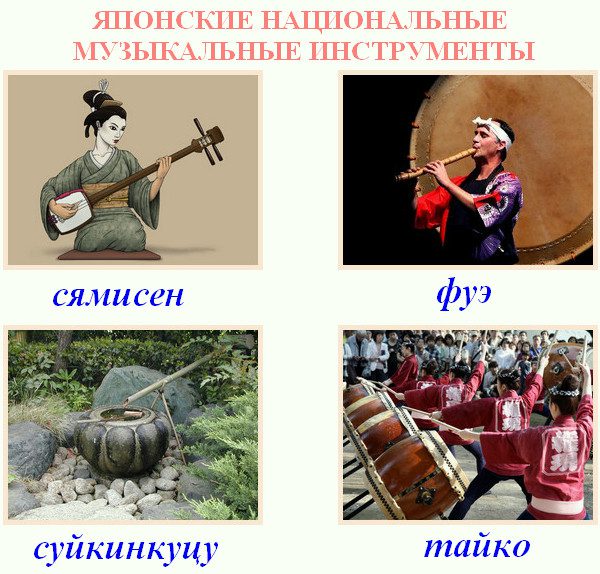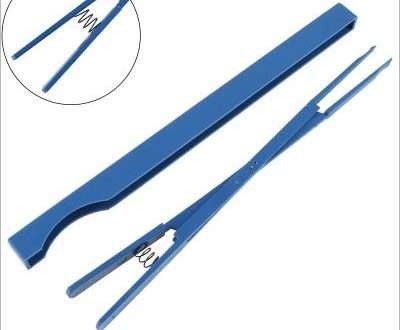
Japanese folk music: national instruments and genres
Contents
 Japanese folk music is a rather distinctive phenomenon due to the isolation of the Islands of the Rising Sun and the careful attitude of the people inhabiting them to their culture.
Japanese folk music is a rather distinctive phenomenon due to the isolation of the Islands of the Rising Sun and the careful attitude of the people inhabiting them to their culture.
Let us first consider some Japanese folk musical instruments, and then the genres characteristic of the musical culture of this country.
Japanese folk musical instruments
Shiamisen is one of the most famous musical instruments in Japan, it is one of the analogues of the lute. The shamisen is a three-stringed plucked instrument. It arose from sanshin, which in turn came from the Chinese sanxian (both the origin is interesting and the etymology of the names is entertaining).
Shamisen is still revered today on the Japanese islands: for example, playing this instrument is often used in traditional Japanese theater – Bunraku and Kabuki. Learning to play the shamisen is included in maiko, a training program in the art of being a geisha.
Phew are a family of high-pitched (most common) Japanese flutes that are usually made from bamboo. This flute originated from the Chinese pipe “paixiao”. The most famous of the fouet is to grope, an instrument of Zen Buddhist monks. It is believed that the shakuhachi was invented by a peasant when he was transporting bamboo and heard the wind blowing a melody through the hollow stems.
Often fue, like shamisen, is used for musical accompaniment to the actions of Banraku or Kabuki theater, as well as in various ensembles. In addition, some of the fouet, tuned in a Western manner (like chromatic instruments), can be soloed. Initially, playing the fue was only the prerogative of wandering Japanese monks.
Suikinkutsu – an instrument in the form of an inverted jug, over which water flows, entering through the holes, it makes it sound. The sound of suikinkutsu is somewhat similar to a bell.
This interesting instrument is often used as an attribute of a Japanese garden; it is played before a tea ceremony (which can take place in a Japanese garden). The thing is that the sound of this instrument is very meditative and creates a contemplative mood, which is ideal for immersion in Zen, because being in the garden and the tea ceremony are part of the Zen tradition.
Taiko – translated from Japanese into Russian this word means “drum”. Just like drum counterparts in other countries, taiko was indispensable in warfare. At least, this is what the chronicles of Gunji Yeshu say: if there were nine blows of nine, then this meant calling an ally into battle, and nine of three meant that the enemy must be actively pursued.
Important: during drummers’ performances, attention is paid to the aesthetics of the performance itself. The appearance of a musical performance in Japan is no less important than the melody or rhythm component.

Musical genres of the Land of the Rising Sun
Japanese folk music went through several stages of its development: initially it was music and songs of a magical nature (like all nations), then the formation of musical genres was influenced by Buddhist and Confucian teachings. In many ways, traditional Japanese music is associated with ritual events, holidays, and theatrical performances.
Of the most ancient forms of Japanese national music, two genres are known: seven (Buddhist chants) and gagaku (court orchestral music). And musical genres that do not have roots in antiquity are yasugi bushi and enka.
Yasugi busi is one of the most common folk song genres in Japan. It is named after the city of Yasugi, where it was created in the mid-19th century. The main themes of Yasugi Bushi are considered to be key moments of local ancient history, and mythopoetic tales about the times of the gods.
“Yasugi bushi” is both the dance “dojo sukui” (where catching fish in the mud is shown in a comic form), and the art of musical juggling “zeni daiko”, where hollow bamboo stems filled with coins are used as an instrument.
Enka – This is a genre that originated relatively recently, just in the post-war period. In enke, Japanese folk instruments are often woven into jazz or blues music (an unusual mix is obtained), and it also combines Japanese pentatonic scale with European minor scale.
Features of Japanese folk music and its difference from the music of other countries
Japanese national music has its own characteristics that distinguish it from the musical cultures of other nations. For example, there are Japanese folk musical instruments – singing wells (suikinkutsu). You’re unlikely to find something like this anywhere else, but there are musical bowls in Tibet, too, and more?
Japanese music can constantly change rhythm and tempo, and also lack time signatures. The folk music of the Land of the Rising Sun has completely different concepts of intervals; they are unusual for European ears.
Japanese folk music is characterized by maximum proximity to the sounds of nature, a desire for simplicity and purity. This is no coincidence: the Japanese know how to show beauty in ordinary things.




